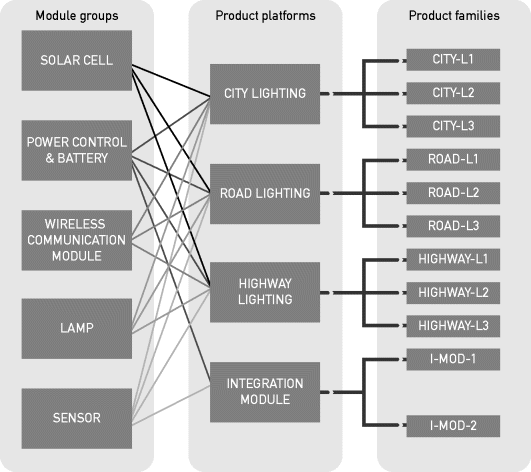2.2 Platform-Driven Product Development
2.2.1 Introduction
In a global, intense, and dynamic competitive environment, the development of new products and processes has become a focal point of attention for many companies. Shrinking product life cycles, increasing international competition, rapidly changing technologies, and customers demanding high variety options are some of the forces that drive new development processes. More variety will make it more likely that each consumer finds exactly the option he or she desires, and will allow each individual consumer to enjoy a diversity of options over time. In considering the implementation of product variety, companies are challenged to create this desired variety economically. In their quest to manage product variety, firms in most industries are increasingly considering product development approaches that reduce complexity and better leverage investments in product design, manufacturing, and marketing (Krishnan and Gupta, 2001). Platform thinking, the process of identifying and exploiting commonalities among a firm's offerings, its target markets, and the processes for creating and delivering offerings, appears to be a successful strategy to create variety with an efficient use of resources (Halman, Hofer, and van Vuuren, 2003). Key in this approach is the sharing of components, modules, and other assets across a family of products. Historical success stories such as the Sony Walkman, Black and Decker power tools, Hewlett Packard's Deskjet printers, Microsoft's Windows NT, and Minolta's “intelligent lens technology” have shown both the benefits and the logic behind the platform concept. Gupta and Souder (1998) even claim that thinking in terms of platforms for families of products rather than individual products is one of the five key drivers behind the success of short-cycle-time companies.
2.2.2 Definitions
The terms product families, platforms, and individual products are hierarchically different and cannot be used as synonyms. A product family is the collection of products that share the same assets (i.e., their platform) (Sawhney, 1998). A platform is therefore neither the same as an individual product nor the same as a product family; it is the common basis of all individual products within a product family (McGrath, 1995; Robertson and Ulrich, 1998). As a consequence, a platform is always linked to a product family, while it can serve multiple product lines in the market. The leading principle behind the platform concept is to balance the commonality potential and differentiation needs within a product family. Figure 2.2.1 shows how Skil, a developer of multiple product families (consisting of, e.g., a set of saws, drills, routers, and grinders), utilizes as much as possible the same technical components for its different brand segments even though they have their own styling and perceived worth.
Figure 2.2.1 Platform-based development of product families within Skil
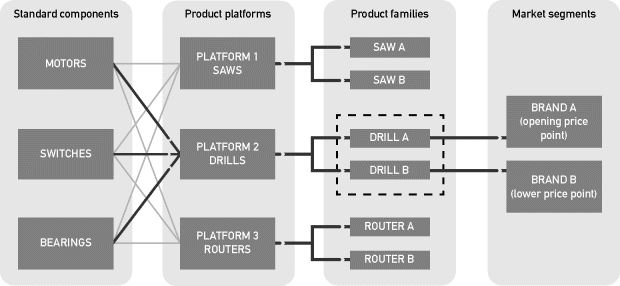
One possibility to build a platform is to define it by means of the product architecture. This product platform has been defined by McGrath (1995) as a set of subsystems and interfaces that form a common structure from which a stream of related products can be efficiently developed and produced. Baldwin and Clark (1999) define three aspects of the underlying logic of a product platform: (1) its modular architecture, (2) the interfaces (the scheme by which the modules interact and communicate), and (3) the standards (the design rules to which the modules conform). The main requirements for building a product family based on a product platform are (1) a certain degree of modularity to allow for the decoupling of elements, and (2) the standardizing of a part of the product architecture (i.e., subsystems and/or interfaces). A modular product architecture in this context is characterized by a high degree of independence between elements (modules) and their interfaces.
The typical inclination is to only think of the product architecture as the basis for a common platform of a product family. In line with discussions in literature (Meyer and Lehnerd, 1997; Robertson and Ulrich, 1998; Sawhney, 1998), we argue that a product family should ideally be built not only on elements of the product architecture (components and interfaces) but also on a multidimensional core of assets that also include processes along the whole value chain (e.g., engineering and manufacturing), customer segmentation, brand positioning, and global supply and distribution.
Process platform refers to the specific setup of the production system to easily produce the desired variety of products. A well-developed production system includes flexible equipment, for example programmable automation or robots, computerized scheduling, flexible supply chains, and carefully designed inventory systems (Kahn, 1998). Sanderson and Uzumeri (1995) refer in this respect to Sony's flexible assembly system and an advanced parts orientation system, designed specifically with flexibility, small-lot production, and ease of model change in mind. Although the costs of this multifunction machine may be twice as much as those of a comparable single-function machine, the greater flexibility possible using manufacturing equipment designed with multiple products and rapid changeover in mind offsets its initial cost. Figure 2.2.2 illustrates how process platforms can be created by searching for potential commonalities in the production process of different product lines of CDs, CD-Rs, DVDs, and DVD-Rs.
Figure 2.2.2 Process platforms in the production of CDs, CD-Rs, DVDs, and DVD-Rs

Customer platform is the customer segment that a firm chooses as its first point of entry into a new market. This segment is expected to have the most compelling need for the firm's offerings and can serve as a base for expansion into related segments and application markets (Sawhney, 1998). Established customer relationships and knowledge of customer needs are used as a springboard to expand by providing step-up functions for higher price– performance tiers within the same segment or to add new features to appeal different segments (Meyer, 1997).
Brand platform is the core of a specific brand system. It can either be the corporate brand (e.g., Philips, Toyota, and Campbell) or a product brand (e.g., Pampers, Organics, and Nivea). From this brand platform, subbrands can be created, reflecting the same image and perceived worth (e.g., Philishave, Hugo Boss perfumes, and Organics shampoo). With a small set of brand platforms and a relatively large set of subbrands, a firm can leverage its brand equity across a diverse set of offerings (Sawhney, 1998).
Global platform is the core standardized offering of a globally rolled-out product. As an example, designing software for a global market can be a challenge. The goal is to have the application support different locales without modifying the source code. A global rollout plan details the aspects of the product that can be standardized as well as those aspects that should be adapted to country-specific conditions and customer preferences. Customization can involve physical changes in the product, and adaptation in pricing, service, positioning message, or channel (Sawhney, 1998).
2.2.3 The Creation of Platform-Based Product Families
Cost and time efficiencies, technological leverage, and market power can be achieved when companies redirect their thinking and resources from single products to families of products built upon robust platforms. Implementing the platform concept can significantly increase the speed of a new product launch. The platform approach further contributes to the reduction of two major resources (i.e., cost and time) in all stages of new product development. By using standardized and pretested components, the accumulated learning and experience in general may also result in higher product performance. Unfortunately, this is not a one-time effort. New platform development must be pursued on a regular basis, embracing technological changes as they occur and making each new generation of a product family more exciting and value-rich than its predecessors. Meyer and Lehnerd (1997) propose a general framework for product family development (see Figure 2.2.3).
Figure 2.2.3 Product family evolution, platform renewal, and new product creation (adapted from Meyer and Lehnerd, 1997)
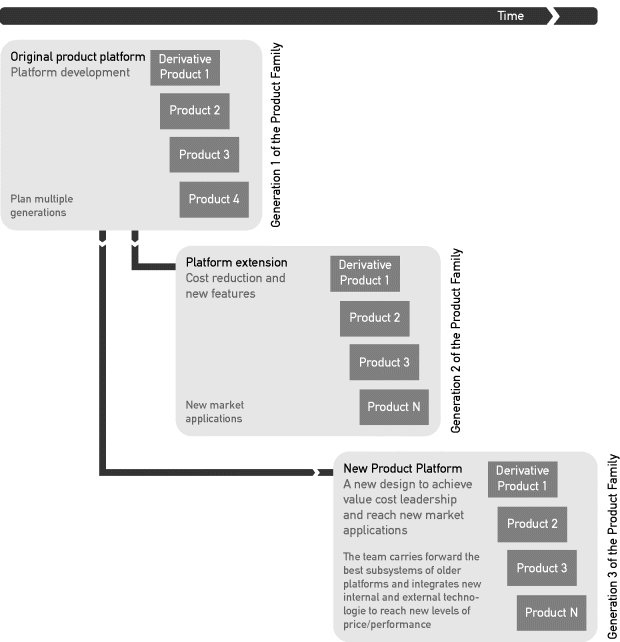
This framework represents a single product family starting with the initial development of a product platform, followed by successive major enhancements to the core product and process technology of that platform, with derivative product development within each generation. New generations of the product family can be based on either an extension of the product platform or an entirely new product platform. In case of an extension, the constellation of subsystems and interfaces remains constant, but one or more subsystems undergo major revision in order to achieve cost reduction or allow new features. An entirely new platform emerges only when its basic architecture changes and aims at value cost leadership and new market applications. Systems and interfaces from prior generations may be carried forward into the new design but are joined by entirely new subsystems and interfaces.
The more consistent a platform concept is defined and implemented in terms of parts, components, processes, customer segmentation, and so on, the more effective a company can operate in terms of tailoring products to the needs of different market segments or customers.
An effective evolution of a product family requires that in collective fashion three essential elements are considered (Figure 2.2.4):
- Potential market applications: What type of products can be offered to different market segments? Customers care whether the firm offers a product that closely meets their needs. Closely meeting the needs of different market segments requires distinctive products.
- Potential commonalities between the distinctive products that can be achieved: What are the design, manufacturing, and cost benefits that can be achieved by maximizing the extent to which distinctive products share, for example, common components, manufacturing processes, and distribution channels?
- Platform strategy definition: This is determined by making trade-off decisions between distinctiveness and commonality. In the ideal case, the platform design represents a relatively high level of commonality that is achieved without much sacrifice in distinctiveness while distinctiveness declines slowly as commonality is increased.
2.2.4 The Platform-Planning Process
Platform planning is a cross-functional activity involving at least the firm's product- marketing, design, and manufacturing functions. Robertson and Ulrich (1998) advocate a loosely structured process for platform planning focused on three information management tools: the product plan, the differentiation plan, and the commonality plan.
Figure 2.2.4 The evolution of product families (adapted from Meyer and Lehnerd, 1997)
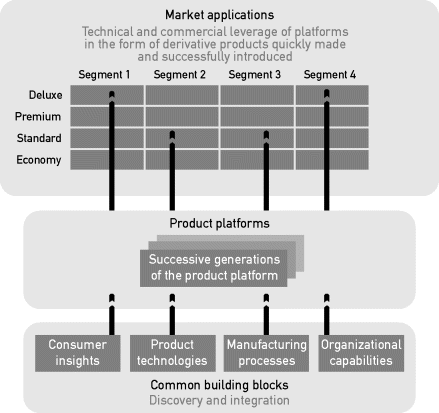
The Product Plan
The product plan specifies the distinct marketing offerings over time and usually comes from the company's overall product plan that identifies the portfolio of products to be developed by the organization and the timing of their introduction to the market. The product plan identifies major models but does not show every variant and option. It is linked to other issues and pieces of information:
- Availability of development resources.
- Life cycles of current products.
- Expected life cycles of competitive offerings.
- Timing of major production system changes.
- Availability of product technologies.
The product plan reflects the company's product strategy. Some companies choose to issue several products simultaneously; others choose to launch products in succession.
The Differentiation Plan
The differentiation plan explicitly represents the ways in which multiple versions of a product will be different from the perspective of the customer and the market. The plan consists of a matrix with rows for the differentiating attributes of the product and with columns for the different versions or models of the product, where the last one gives an approximate assessment of the relative importance to the customer of each differentiation attribute. Differentiating attributes (DAs) are those characteristics of the product that are both important to the customer and intended to be different across the products. A common pitfall in platform planning is to become bogged down in detail. The best level of abstraction results in no more than 10–20 DAs.
The team uses the differentiation plan to codify each decision about how the product will be different. On the first pass, the differentiation plan represents the ideal case of each product's differentiation for maximum appeal to customers in the target segments. On subsequent iterations, the ideal case is adjusted to respond to the need for commonality.
The Commonality Plan
The commonality plan describes the extent to which the products in the plan share physical elements. The plan is an explicit accounting of the costs associated with developing and producing each product. It consists of a matrix with rows representing the chunks of the product (listed in the first column). The term chunk is used to refer to the major physical elements of a product. A set of products exhibits high levels of commonality if many chunks are shared. To manage complexity, the team should limit the number of chunks to roughly the number of DAs. The remaining columns identify the products in the plan, according to the timing of their development and the metrics used in the commonality plan as number of unique parts, development costs, tooling costs, and manufacturing costs. The values of these metrics are estimated because actual values cannot be determined until the products have been designed and produced.
Managing the Trade-Off between Differentiation and Commonality
The challenge in platform planning is to resolve the tension between the desire to differentiate the products and the desire for these products to share a substantial fraction of their components. For most product contexts, an unconstrained product plan and an unconstrained differentiation plan lead to high costs. For this reason, iterative problem solving is required to balance the need for differentiation with the need for commonality. This iterative activity involves both moving along the distinctiveness–commonality curve and exploring alternate product architectures with different associated trade-off characteristics (Figure 2.2.5).
Figure 2.2.5 Trade-off between distinctiveness and commonality (adapted from Robertson and Ulrich, 1998)

2.2.5 Modular versus Integral Product Architectures
Product architecture is defined by Ulrich (1995) as the scheme by which the function of a product is allocated to physical components. The function of a product can be broken down into a number of functional elements (sometimes also called functional requirements), which are the individual operations that a product performs. The components of a product can be thought of as physical elements, which are the parts and subassemblies that realize the function of the product. The components are usually arranged into major building blocks, called chunks, made up of a number of components. The mapping between functional elements and components may be one-to-one, many-to-one, or one-to-many. Product architectures can be distinguished into modular and integral architectures. A modular architecture includes a one-to-one mapping from functional elements in the function structure to the physical components of the products, and specifies decoupled interfaces between components. An integral architecture, on the other hand, includes a complex multirelational mapping from functional elements to physical components and/or coupled interfaces between components. But which one is better?
Product Change
The architecture of a product is closely linked to the ease with which change to a product can be implemented. Products frequently undergo some change during their life due to upgrade, add-ons, adaptation, wear, consumption, and flexibility in use motives. In each of these cases, changes to the product are most easily accommodated through modular architectures. The modular architecture allows the required changes that are typically associated with the product's function to be localized to the minimum possible number of components. However, another popular strategy is to dramatically lower the cost of the entire product, often through an integral architecture, such that the entire product can be discarded or recycled in case of wear and consumption. For example, disposable razors, cameras, and cigarette lighters have all been commercially successful products, and disposable pens dominate the market place.
It is also possible to find change across generations of the product. When a new model of an existing product is introduced to the market place, the product always embodies some functional change relative to the previous product. For products with a modular architecture, desired changes to a functional element can be localized to one component, whereas products with integral architectures require changes to several components in order to implement changes to the product's function.
Product Variety
Ulrich (1995) defines product variety as the diversity of products that a production system provides to the marketplace. The ability of a firm to economically create variety resides not only with the flexibility of the equipment in the factory but also with the architecture of the product. A modular-designed camera, for instance, allows the use of different types of lenses (see Figure 2.2.6).
Figure 2.2.6 Modularity in product design

With a modular product architecture, product variety can be achieved with or without flexible component production equipment. In relative terms, in order to economically produce high variety with an integral architecture, the component production equipment must be flexible. This argument assumes in all cases that the final assembly process itself is somewhat flexible, that is, different combinations of components can be easily assembled to create the final product variety.
Component Standardization
Component standardization is the use of the same component in multiple products. Standardizing parts like axles, steering columns, and most importantly chassis helps the Volkswagen Auto Group to lower its production costs and cut assembly times. Shared parts also allow the Volkswagen Auto Group to produce cars from different brands such as Audi, Seat, Skoda, Scania, and Volkswagen at the same plant. A modular architecture increases the likelihood that a component will be commonly useful and also enables component interfaces to be identical across several products.
A standard interface, for instance, to connect all types of lenses (see Figure 2.2.7) allows the use of a wide variety of lenses for different types of cameras.
Figure 2.2.7 Outdoor lighting system
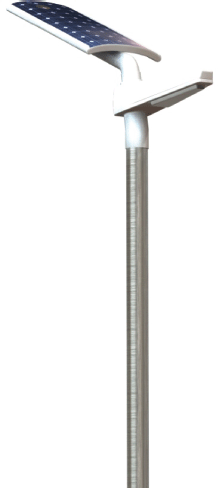
Component standardization has implications for the manufacturing firm in the areas of cost, product performance, and product development. Standard components can be less expensive (produced in high volume), exhibit higher performance (learning and experience), and lower the complexity, cost, and lead time of product development (known entity).
Product Performance
Ulrich (1995) defines product performance as how well the product implements its functional elements. Modular architectures allow for optimization of local performance characteristics by using a standard component or, when this is not available, modular architectures allow the component to be designed, tested, and refined in a focused way. Architecture also influences the improvement of global performance characteristics usually measured in such ways as efficiency, size, weight, and speed. An integral architecture facilitates the optimization of holistic performance characteristics and those that are driven by the size, shape, and mass of a product. Such characteristics include acceleration, energy consumption, aerodynamic drag, noise, and aesthetics.
The practice of implementing multiple functions using a single physical element is called function sharing. An integral architecture allows for redundancy to be eliminated through function sharing and allows for geometrical nesting of components to minimize the volume a product occupies. Such function sharing and nesting also allow materials to be minimized, potentially reducing the cost of manufacturing the product.
There are no deterministic approaches to choosing optimal product architecture. Ulrich (1995) concludes that in most cases the choice will not be between a completely modular or completely integral product architecture, but rather will be focused on which functional elements should be treated in a modular way (thus enabling the creation of one or more product platforms) and which should be treated in an integral way. And as pointed out by Meyer, Tertzakian, and Utterback (1997), excellence in product platform design is fundamental to the quality and success of a product family, consisting of a basic architecture composed of modules and the interfaces between these modules.
2.2.6 Measuring the Performance of Product Families
In managing product families, there are a number of frequently asked questions: When should we renew our platform? How much will platform efforts cost, and how long should we expect them to take? What types of engineering and commercial benefits can we expect to gain from these efforts once they are completed? How can we improve our approaches and strategies for product development?
Meyer, Tertzakian, and Utterback (1997) as well as Meyer and Lehnerd (1997) have developed measures to evaluate a platform's efficiency and effectiveness. To measure platform efficiency and effectiveness, the following data are required:
- Engineering costs: These costs comprise the amount of money spent on developing platforms and specific derivative products.
- Development time: The time spent from start to finish in platform and derivative product development. For derivative products, the development time cycle starts at the point of specific engineering work for the product itself and ends at the time of release to manufacturing.
- Manufacturing costs: These are the costs of upgrading a manufacturing facility to handle new products.
- Market development costs: These data may include expenditures on specific promotional campaigns for a new product, channel development expenses, and dealer-training programs.
- Sales data: Sales data for each product in a family should be aggregated across its full commercial life cycle.
- Margins: These data link profit to specific products.
Platform Efficiency
Platform efficiency is defined as the degree to which a platform allows the economical generation of derivative products.
![]()
This metric can be used to understand development efficiency for an entire generation of derivative products, computing the average R&D costs of the derivative products for a particular platform version and then dividing that amount by that platform version's own development costs. One can also compare the platform efficiency of different platform versions across different product families.
What is a reasonable platform efficiency value? Meyer and Lehnerd (1997), in their study of firms in the electronics industry, indicated that platform efficiency values of 0.10 or less mark the presence of highly leverageable product platforms, meaning that efficient platforms allow the firm to produce derivative products at roughly 10% of the cost of developing associated base platform architectures. However, the desirable benchmark value for a particular company will be industry specific. They recommend studying a successful product family in the company, determining its level of platform efficiency, and then using that as a benchmark for similar groups inside the business.
If resources are being effectively used and learning is taking place, platform efficiency should improve with each successive platform version of a product family. Platform efficiency can be used as an indicator of platform demise. An increase in its value over successive derivative products may indicate weakness in the underlying product architecture. It can also signify a change in management or key resources, human or otherwise. Market factors can also substantially influence the efficiency with which existing platforms can be leveraged into new products, particularly when the market applications are novel to the firm.
Note that the metric, so far, has included only engineering costs. A more comprehensive understanding emerges if one considers the cost ratios for introducing new products into full-scale production.
Platform Effectiveness
Platform effectiveness is defined by Meyer, Tertzakian, and Utterback (1997) as the degree to which product platform–based products produce revenue for the firm relative to the cost of developing those products. Platform effectiveness simply compares the resources used to create products with the revenues derived from them, over the long term. The cost of development includes the engineering costs, manufacturing engineering costs, market development costs, and expenditures for plant and equipment. Revenues consist of net sales attributable to each derivative product within the family. Platform effectiveness for a single derivative product is represented as follows (Meyer and Lehnerd, 1997):
![]()
The effectiveness measure can be aggregated for an entire generation of products, allowing one to compare the performance of successive generations:Platform effectiveness for a generation of products

As pointed out by Meyer et al., there are many factors that can lead to declining platform effectiveness. First, the platform itself may have outlived its utility as a basis for creating specific products that are competitive in the market in their features and cost. This would lead to declining sales, affecting the numerator of the effectiveness equations. As for the denominator, R&D costs may be rising due to problems in platform efficiency. Besides, a market either in explosive growth or in free fall will greatly impact the metric.
How is platform effectiveness defined for your company's product lines? Meyer and Lehnerd (1997) again suggest that platform effectiveness values will vary from industry to industry and that the most pragmatic way to establish a benchmark for platform effectiveness in the company is through internal study, observing those values associated with the most successful product families.
Taken together, these measures of platform efficiency and effectiveness should be interpreted to evaluate if a specific product platforms needs renewal. When the underlying architectures of major product lines are running out of gas in their ability to (1) facilitate rapid and cost-effective development of derivative products, and (2) deliver the features required by customers at price point that would lead to continued strong sales, it will be necessary to fund and sequence new platform development projects to supersede existing platforms.
2.2.7 Managing Risk in Platform-Based Development
Platform-based development may not be appropriate for all product and market conditions. It still remains difficult to anticipate the consequences of risky platform decisions in advance.
Developing the initial platform in most cases requires more investments and development time than developing a single product, delaying the time to market of the first product and affecting the return on investment time. Also, the failure to develop new platform architectures on a continuous basis subjects the firm to substantial market risk. It stands to reason that if new platform development efforts take longer to complete than derivative products efforts, R&D aimed at platform renewal should be pursued concurrent with derivative products developments on existing platforms. That ensures a continuous stream of products embodying competitive technology (Meyer and Lehnerd, 1997; Meyer, Tertzakian, and Utterback, 1997) Long-term success and survival require continuing innovation and renewal. A potential negative implication of a modular product architecture approach is the risk of creating barriers to architectural innovation. This problem has been identified by Henderson and Clark (1990) in the photolithography industry and may in fact be a concern in many other industries as well.
On top of the fixed investments in developing platforms, platforms may also result in the over-design of low-end variants in a firm's product family to enable subsystem sharing with high-end products (Krishnan and Gupta, 2001). An additional risk concerns the balance between commonality and distinctiveness. A weak common platform will undermine the competitiveness of the entire product family, and therefore a broad array of products will lose competitiveness. Robertson and Ulrich (1998) have pointed out organizational risks related to platform development. Platform development requires multifunctional groups. Problems may arise over different time frames, jargon, goals, and assumptions. In a lot of cases, organizational forces also seem to hinder the ability to balance between commonality and distinctiveness. Engineers, for example, may prepare data showing how expensive it would be to create distinctive products, while people from marketing may argue convincingly that only completely different products will appeal to different markets. One perspective can dominate the debate in the organization.
Finally, the metrics as suggested by Meyer, Tertzakian, and Utterback (1997) can help to monitor, but they do not explicitly say when to create a new platform, and companies can fail to embark in platform renewal in a timely manner.
2.2.8 Application of Platform-Driven Product Development
The student project by Scholder and Friso (2007) comprised the conceptual development of an outdoor LED lighting system for public spaces powered by PV modules (see Figures 2.2.7 and 2.2.8).
Figure 2.2.8 Scheme representing the technical functioning of this product
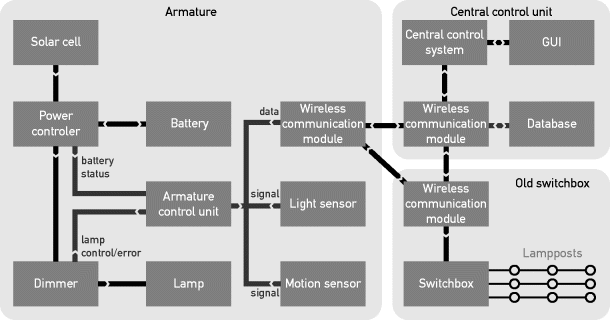
During the design process of this project, the students applied platform-driven product development to be able to design suitable solutions for various markets. They were thinking about different types of urban lighting such as city lighting, road lighting, and highway lighting (see Figure 2.2.9). In this way they could ensure a short time to market and guarantee a high reliability. By using a lot of standard modules, the costs for development and production are reduced, and the number of parts in stock can be reduced.
Figure 2.2.9 Product platform for the product shown in Figure 2.2.7
